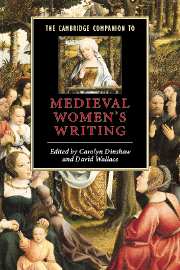Introduction
Published online by Cambridge University Press: 28 May 2006
Summary
This volume explores medieval women’s involvement with textual culture. The women of our study are chiefly those living in England, viewed as part of a greater medieval Europe. To do full justice to such involvement, our title would need to be very long indeed; the whole volume might in fact be seen as an attempt to qualify or tease out the meanings of ‘medieval women’s writing’. The image featured as frontispiece and paperback cover of this book speaks eloquently to many of these issues, hence provides ways of beginning.
The painting, now in the Philadelphia Museum of Art (Johnson Collection 402), dates from c. 1500–20. Although not painted in England, its subject would have been recognized by English observers: for it depicts scenes from the life of Mary Magdalene deriving from The Golden Legend of Dominican friar Jacobus de Voragine (compiled 1259–66).1 Chaucer drew on this Legenda aurea for his tale of St Cecilia (and perhaps for his lost Magdalene legend); the early English printer William Caxton produced his own edition from Latin, French, and English sources (subsequently reprinted by Wynkyn de Worde, Pynson, and Notary). Our image and this spread of dates thus suggest a culture that, while alive to local and temporal particulars – as detailed in the fashionable costumes – nonetheless preserves some remarkable continuities in experience over time and space. Continuities may also be read across the essays of this volume, suggesting that ‘medieval women’s writing’ provides (with due account taken of experiences differentiated by age, class, and marital status) viable terms of analysis.
- Type
- Chapter
- Information
- The Cambridge Companion to Medieval Women's Writing , pp. 1 - 10Publisher: Cambridge University PressPrint publication year: 2003



